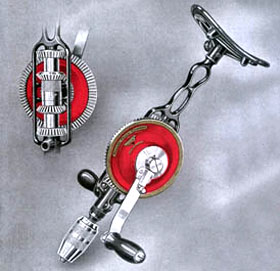Millers Falls Breast Drills
 Breast drills typically exceed fifteen inches in length and are topped by a concave plate that provides a surface for a user to lean against when drilling a hole. Sometimes referred to as "chest drills," "belly drills" or "knee drills," these tools were indispensable in the construction industry, in blacksmith shops, in factories and in shops where rail cars were fabricated. Ruggedly built, the drills are useful for boring holes in iron, steel and extremely tough wood. Designed with the expectation that a worker would be putting a fair amount of body weight into a task, the drills are especially effective when used in a standing position, alongside the work piece.
Breast drills typically exceed fifteen inches in length and are topped by a concave plate that provides a surface for a user to lean against when drilling a hole. Sometimes referred to as "chest drills," "belly drills" or "knee drills," these tools were indispensable in the construction industry, in blacksmith shops, in factories and in shops where rail cars were fabricated. Ruggedly built, the drills are useful for boring holes in iron, steel and extremely tough wood. Designed with the expectation that a worker would be putting a fair amount of body weight into a task, the drills are especially effective when used in a standing position, alongside the work piece.
Breast drills are not to be confused with hand drills. Hand drills are generally fifteen inches or less in length, are best suited for drilling holes in wood and light metals and are most effective when used by a worker whose body is positioned above a work piece. The distinctions between the two types are not hard and fast, however, and the Millers Falls Company manufactured a handful of tools that did not quite fit into either category. Several of its large hand drills exceeded fifteen inches. (One was even fitted with a breast plate.) Some of the company's breast drills came equipped with a D-type handle, rather than the traditional breast plate. (D-type handles convert breast drills into tools especially useful for workers positioned above or below a work piece.) The tools discussed in this part of the web site are those which the company chose to call breast drills; those which the company referred to as "hand drills" are treated in the hand drill pages.
The illustration above is taken from one of the colored plates in the Millers Falls Company's large format Catalog No. 38, published in February 1922. The tool depicted is the No. 97 breast drill—certainly one of the most sophisticated drills the company ever produced. The No. 97, a two-speed unit, featured an adjuster knob on its crank that allowed a user to shift from low to high gear without pulling the drive gear in order to reposition it. The drill was also equipped with a ratchet that enabled a worker to bore a hole without completing a full rotation of the handle. The No. 97's ratchet mechanism was so advanced that the company referred to the tool as a "continuous motion" drill. Adjustable to any one of five positions, the ratchet could be locked, set to rotate to the right, set to rotate to the left, set to rotate to the right without regard to the direction of the crank rotation, and set to rotate to the left without regard to the direction of the crank rotation.
Oddly, the company continued to market breast drills into the 1980s. Although the drills were already an anachronism, competitors were so few that it had the market pretty much to itself.